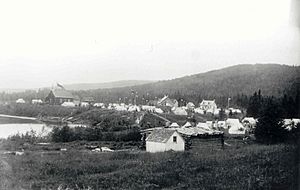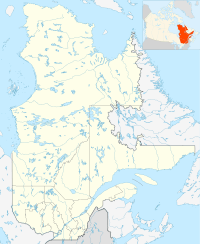Wemotaci facts for kids
Quick facts for kids
Wemotaci
|
|
|---|---|
|
First Nations reserve
|
|

Weymontachie, 1913
|
|
| Country | |
| Province | |
| Region | Mauricie |
| Census division | La Tuque |
| Settled | 1806 (trading post) |
| Founded | 1853 (reserve) |
| Area | |
| • Total | 33.30 km2 (12.86 sq mi) |
| • Land | 31.55 km2 (12.18 sq mi) |
| Population
(2021)
|
|
| • Total | 1,142 |
| • Density | 36.2/km2 (94/sq mi) |
| Time zone | UTC-5 (EST) |
| • Summer (DST) | UTC-4 (EDT) |
| Postal Code |
G0X 3R0
|
| Area code(s) | 819 |
| Website | www.wemotaci.com |
Wemotaci is a special place in Quebec, Canada. It is a First Nations reserve, which means it's land set aside for Indigenous people. This community is located on the north side of the Saint-Maurice River. It sits where the Manouane River joins the Saint-Maurice.
Wemotaci is part of the Mauricie region of Quebec. It is home to people of the Atikamekw First Nation. Other Atikamekw communities nearby include Obedjiwan and Coucoucache Indian Reserve No. 24.
The reserve is like an island inside the city of La Tuque. The Saint-Maurice River forms its western and southern borders. You can reach Wemotaci by a gravel road from La Tuque. This road goes through a small village called Sanmaur. A railway bridge also crosses the river at Sanmaur.
Contents
What People Do in Wemotaci
The people of Wemotaci have many ways to earn a living. Their economy includes making and selling art and crafts. They also have local shops and services.
Forestry, which is about managing forests, is important here. Some people work in trapping animals for their fur. Construction jobs and tourism also help the economy. Transport services and businesses that help people with outdoor activities, like hunting or fishing, are also part of the local economy.
The Name Wemotaci
The name Wemotaci has changed its spelling many times over the years. This is common for Indigenous names. The earliest record of the name is from 1724.
For a long time, the name was often spelled Weymontachingue. This spelling was used on a map in 1932. In 1986, the local leaders asked for the name to be changed to Weymontachie. Finally, in March 1997, the official spelling became Wemotaci. This is how it is spelled in the Atikamekw language.
A Look at Wemotaci's History
The land around the upper Saint-Maurice River has always been home to the Atikamekw people. They used these lands for hunting and living.
In 1806, a trading post was built in Wemotaci. This was a place where people could trade furs and other goods. In 1821, the Hudson's Bay Company took over this trading post.
In 1851, the government decided to set aside land for Indigenous tribes. Two years later, in 1853, some of this land was given to the Atikamekw people. This officially created the reserve.
However, the Atikamekw people were nomadic, meaning they moved around. They did not settle on the reserve right away. It wasn't until 1895 that the reserve land was properly measured.
Later, a dam was built and a railway came through the area. This led to the growth of a nearby settlement called Sanmaur. These changes encouraged the Atikamekw people to move to the reserve in the early 1900s.
In 1939, the Hudson's Bay Company left Wemotaci. Without their support, the village stopped growing after 1950. Many people moved to Sanmaur or other nearby villages.
In the 1970s, the village started to grow again. A new village area was built closer to a mountain with the same name. In 1971, the Canadian government bought the old Hudson's Bay Company lands. These lands were then added to the reserve.
In May 2010, a large forest fire threatened the homes in Wemotaci. Many residents had to leave their homes for safety.
People and Language
Wemotaci is home to over 1,100 people. The community has seen its population grow over the years.
Most people in Wemotaci speak the Atikamekw language. About 96% of the community speaks Atikamekw as their first language. A small number of people speak French.
Education in Wemotaci
There are two schools in the Wemotaci reserve. These schools help children and teenagers get their education:
- École Seskitin: This school teaches younger students, from Pre-Kindergarten up to Secondary grade 1.
- École Waratinak Nikanik: This school is for older students, from Secondary 1 to Secondary 5.


